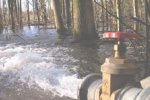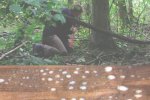Project
Vessel area of oak - a new proxy to determine changing environments through the Holocene
What is the natural variation in climatic factors throughout the Holocene? How will future climate change affect trees and forests in Europe? These are important questions that can be studied using tree rings as natural archives.
High-resolution wood anatomical characters have found to be sensitive indicators of climate and environmental changes. A new approach is presented whereby earlywood vessel area of oak is used to assess past flooding and dynamics in river discharge. Climate-growth relationships (response functions) will be calculated for oaks in modern floodplain environments and projected on sub-fossil oaks from ancient floodplain forests to reconstruct natural hydrological, climate and environmental changes in the past. Flooding experiments are conducted to gain information on the effect of timing and intensity of flooding on changes in earlywood vessel size.
Cooperation
- A. Land, M. Friedrich, AG Paleobotanic, Institute for Botany, Hohenheim University, project INTERDYNAMIK
- Dr. D. Vansteenkiste, Ghent University, Belgium
- Dr. H. Leuschner, University of Goettingen, Albrecht-von-Haller-Institute, Department of Palynology and Climate Dynamics
- Dr. P. Fonti, Swiss Federal Institute for Forest, Snow and Landscape Research (WSL), Switserland
- S. van Rooij, Alterra, Team Ecological Networks
Publications
- Sass-Klaasen, U.; Sabajo, C.R.; Ouden, J. den (2011) Vessel formation in relation to leaf phenology in pedunculate oak and European ash. Dendrochronologia (Online first) doi:10.1016/j.dendro.2011.01.002
- Stuijfzand, S.; Ek, E. van; Manen, H. van; Hommel, P.W.F.M.; Waal, R.W. de; Pol, J. van de; Daling, J.; Pelsma, T.; Belien, E.; Olsthoorn, A.F.M.; Sass, U.G.W.; Ouden, J. den; Kuijper, M.; Rooij, S.A.M. van; Boonstra, A.; Dijk, H.; Jaarsma, M.; Beemster, A.; Zijlstra, M.; Scheer, A. van der; Hout, A. van der; Groot, l. de; Bosma, N. (2008) Onderzoek naar effecten van waterberging in een jong kleibos : achtergrondrapport Harderbos [Den Haag etc.] : Ministerie van Verkeer en Waterstaat [etc.], (Alterra rapport 1630) - p. 136
- Stuijfzand, S.; Ek, R. van; Belien, E.; Beumer, V.; Croese, E.; Diggelen, R.; Eigenhuijsen, E.; Goeij, S.; Grotenboer, A.; Hommel, P.; Jong, H.; Klein, J.; Kruit, L.; Manen, H. van; Medenblik, J.; Mouissie, M.; Olsthoorn, A.F.M.; Ouden, J. den; Pelsma, T.; Pol, J.; Riksen, M.J.P.M.; Rooij, S. de; Sass-Klaassen, U.; Sival, F.P.; Vegter, U.; Verbeek, L.; Voorde, L.; Waal, R.W. de; Wessels, Y.; Zierfuss, S. (2007). Praktijkervaringen met waterberging in natuur(ontwikkelings)gebieden : hoofdrapport pilotprogramma waterberging en natuur. [S.l.] : RWS Waterdienst [etc.], (Alterra rapport 1632) - p. 92.
- Werf, G.W. van der; Sass-Klaassen, U.; Mohren, G.M.J. (2007). The impact of the 2003 summer drought on the intra-annual growth pattern of beech (Fagus sylvatica l.) and oak (Quercus robur L.) on a dry site in the Netherlands. Dendrochronologia 25 (2). - p. 103 - 112.
MSc theses
- Belien, E. (2008). Spring floods reduse earlywood vessel area of oak (Quercus robur). (supervision: Sass-Klaassen, den Ouden ).
- Sabajo, C. (2009) Early wood vessel formation in pedunculate oak (Quercus robur L.) and common ash (Fraxinus excelsior L.).

